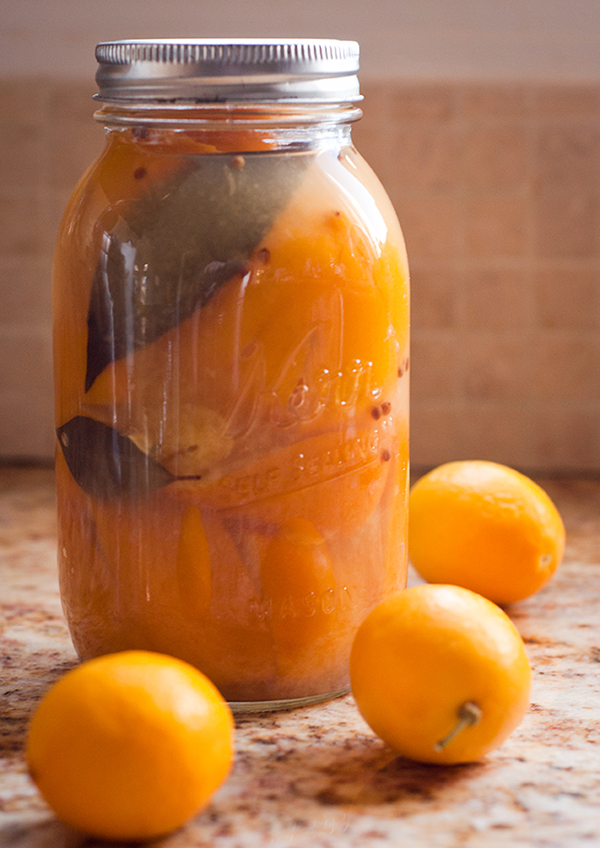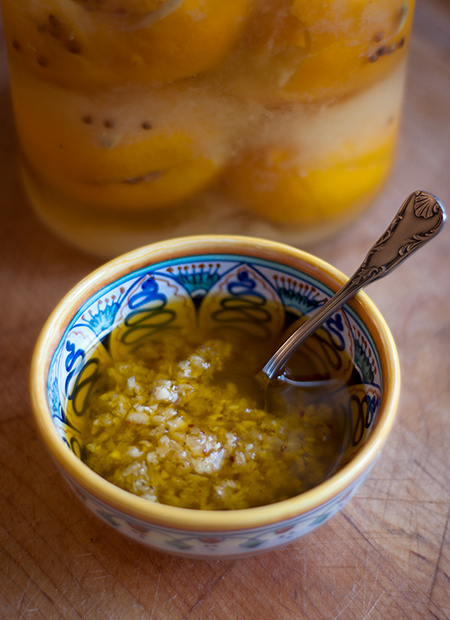Preserved Lemons
Gluten, dairy, egg, soy, yeast and nut free. Vegan
Everyday, lemon zest and juice can lift a dish from bland to delicious while adding bright fresh flavor to a myriad of dishes from leafy salads, to roasted chickens, to savory soups and of course boozy, ice-clinking cocktails. Preserve lemons in salty brine for a month or more and you can exponentially catapult the lemony citrus effect. The remarkable aroma and taste of salt-cured, preserved lemons are at once familiar but also complex; salty and sour—like fresh lemons on overdrive.
Salt curing is an age-old method for preserving food that inhibits the growth of bacteria and fungus; no doubt useful for a trek across the desert on a camel. Today we preserve lemons, or at least I do, because they taste so darn good.
To prepare preserved lemons, look for unwaxed lemons, unless you have a tree or a friend who does. In London, lemons were marked waxed or not. I haven’t seen that distinction here; you’ll have to ask. Typically, organic lemons are not waxed, making them a good choice to preserve. In fact, it makes them a good choice for any use of lemons. If you don’t know if your lemons are waxed, scrub them like the dickens under warm water with a vegetable brush. When in season, January to May, try Meyer lemons. They are most similar to the prized thin-skinned Moroccan doqq lemon and have a sweetness that pushes the flavor a bit towards tangerine (why not preserve tangerines?).
Lemons have three parts— the outer yellow rind or zest, the bitter white pith, and the juicy flesh. Once preserved, the entire rind including the pith becomes edible. Many Moroccan recipes call for using just the rind and pith and would have you discard the flesh. I don’t necessarily agree, but then again, I’m not Moroccan. For marinades and stewy dishes that cook a long time, I chop and use the entire lemon. For sautéed vegetables, I just use finely chopped rind and pith, then squeeze the juice over all to finish the dish.
Since my first batch of preserved lemons, I’ve added them to roast chicken cooked in a brasier; risotto with wild mushrooms or shellfish; sautéed wild Alaskan salmon with dill; lentil, chicken and vegetable soups; lamb and vegetable tagines, marinades for meat and seafood; sautéed greens and many other chicken dishes like chicken and green olives, a classic Moroccan dish that uses preserved lemons. I keep a mixture of chopped garlic and preserved lemon rinds with a smattering of harissa chile covered in olive oil in the refrigerator to use for an instant flavor boost for vegetables, roast meats, or fish.
I usually preserve about 8-9 Eureka lemons at a time, in a half gallon jar. For Meyer lemons (pictured at the top of post), a one quart jars holds about six.
Ingredients:
8-9, unwaxed Eureka or 6-7 Meyer lemons
1 Tablespoon Kosher or sea salt* for each lemon
3- 4 lemons, juiced
* Don’t use ordinary table or iodized salt; it affects the flavor of the preserved lemons.
Preparation:
1. Scrub lemons with a vegetable brush and warm water
2. Cut 3-4 deep gashes diagonally around each lemon through the rind to the pulp
3. Put salt in a bowl large enough for two hands, then one by one pack salt into the gashes of each lemon placing salted lemons in clean glass jar as you go
4. Push lemons down tightly into the jar trying to squeeze lemon juice from the lemons
5. Pour additional lemon juice over all until lemons are completely covered
6. Screw a tight-fitting lid on the jar and place in cool, dark place. I put mine on a shelf in the garage in the Fall and Winter; in the refrigerator in the Spring and Summer.
7. For the first week push lemons down every day. I also jostle the jar a bit as the salt can settle at the bottom.
8. Wait 30 days at least and your lemons are good to go.
Tip: quickly rinse lemons before using to wash off some of the salt.








